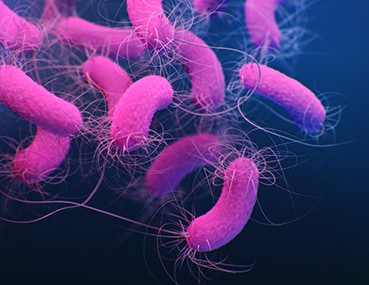www.time2026end.com
Pseudomonas aeruginosa
| Scientific classification | |
|---|---|
| Domain: | Bacteria |
| Phylum: | Proteobacteria |
| Class: | Gammaproteobacteria |
| Order: | Pseudomonadales |
| Family: | Pseudomonadaceae |
| Genus: | Pseudomonas |
| Species: |
P. aeruginosa
|
| Binomial name | |
| Pseudomonas aeruginosa | |
- Gram-negative, rod-shaped bacterium
- P. aeruginosa is a Obligate aerobe
- that can cause disease in plants and animals, including humans.

Pathogen
- It is found in soil, water, skin flora, and most man-made environments throughout the world.
- An opportunistic, nosocomial pathogen of immunocompromised individuals, P. aeruginosa typically infects the airway, urinary tract, burns, and wounds, and also causes other blood infections.[25]
- which can cause infections in the blood, lungs (pneumonia), or other parts of the body after surgery
- The organism is considered opportunistic insofar as serious infection often occurs during existing diseases or conditions

Laboratory diagnosis
Identification
| Test | Results |
|---|---|
| Gram Stain | - |
| Oxidase | + |
| Indole Production | - |
| Methyl Red | - |
| Voges-Proskaeur | - |
| Citrate | + |
| Hydrogen Sulfide Production | - |
| Urea Hydrolysis | - |
| Phenylalanine Deaminase | - |
| Lysine Decarboxylase | - |
| Motility | + |
| Gelatin Hydrolysis | + |
| Acid from lactose | - |
| acid from glucose | - |
| acid from maltose | - |
| acid from mannitol | + |
| acid from sucrose | - |
| nitrate reduction | + |
| DNAse | - |
| Lipase | + |
| Pigment | + (bluish green pigmentation) |
| Catalase | + |
| Hemolysis | Beta/variable |

Treatment
Many P. aeruginosa isolates are resistant to a large range of antibiotics and may demonstrate additional resistance after unsuccessful treatment. It should usually be possible to guide treatment according to laboratory sensitivities, rather than choosing an antibiotic empirically. If antibiotics are started empirically, then every effort should be made to obtain cultures (before administering first dose of antibiotic), and the choice of antibiotic used should be reviewed when the culture results are available.
Antibiotics that may have activity against P. aeruginosa include:


- aminoglycosides (gentamicin, amikacin, tobramycin, but not kanamycin)
- quinolones (ciprofloxacin, levofloxacin, but not moxifloxacin)
- cephalosporins (ceftazidime, cefepime, cefoperazone, cefpirome, ceftobiprole, but not cefuroxime, cefotaxime, or ceftriaxone)
- antipseudomonal penicillins: carboxypenicillins (carbenicillin and ticarcillin), and ureidopenicillins (mezlocillin, azlocillin, and piperacillin). P. aeruginosa is intrinsically resistant to all other penicillins.
- carbapenems (meropenem, imipenem, doripenem, but not ertapenem)
- polymyxins (polymyxin B and colistin)[60]
- monobactams (aztreonam)
Testing Conditions
Medium: Disk diffusion: MHA
Broth dilution: CAMHB
Agar dilution: MHA
Inoculum: Broth culture method or colony suspension, equivalent to a
0.5 McFarland standard
Incubation: 35°C± 2°C; ambient air
Disk diffusion: 16–18 hours
Dilution methods: 16–20 hours
Antimicrobial agent
Disk content
Susceptible
Resistant
piperacillin
100ug
³21
£14
ceftazidime
30ug
³18
£14
piperacillin-tazobactam
100ug
³21
£16
amikacin
30ug
³17
£14
aztreonam
30ug
³22
£15
cefepime
30ug
³18
£14
ceftazidime-avibactam
30ug
³21
£20
ciprofloxacin
15ug
³21
£15
doripenem
10ug
³19
£15
Antimicrobial agent
|
Disk content
|
Susceptible
|
Resistant
|
piperacillin
|
100ug
|
³21
|
£14
|
ceftazidime
|
30ug
|
³18
|
£14
|
piperacillin-tazobactam
|
100ug
|
³21
|
£16
|
amikacin
|
30ug
|
³17
|
£14
|
aztreonam
|
30ug
|
³22
|
£15
|
cefepime
|
30ug
|
³18
|
£14
|
ceftazidime-avibactam
|
30ug
|
³21
|
£20
|
ciprofloxacin
|
15ug
|
³21
|
£15
|
doripenem
|
10ug
|
³19
|
£15
|
Thoroughly washing hands and cleaning equipment in hospitals can help prevent infection. Outside a hospital, avoiding hot tubs and swimming pools that are poorly cared for can help prevent infections. You should remove swimming garments and shower with soap after getting out of the water. Drying your ears after swimming can also help prevent swimmer’s ear.
There are several things you can do to prevent infection if you are recovering from a procedure or receiving a treatment in a hospital:
- Tell your nurse if any of your dressings become loose or look wet.
- Tell your nurse if you think any tubes of IV lines have come loose.
- Make sure you fully understand the treatment or procedure your doctor has requested for you.
M100 Performance Standards for Antimicrobial
Susceptibility Testing-CLSI-2018

Comments